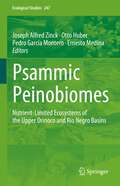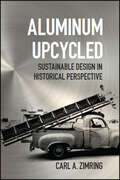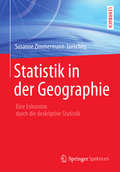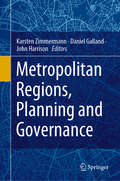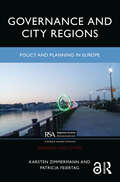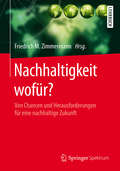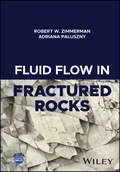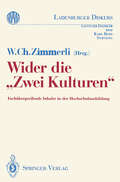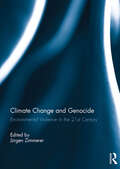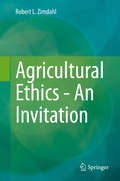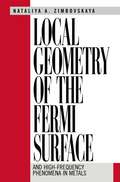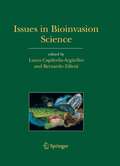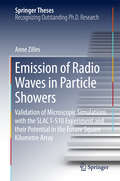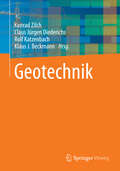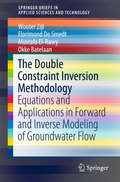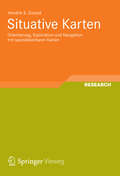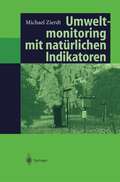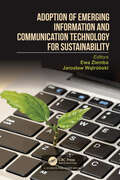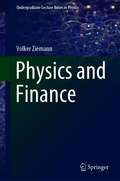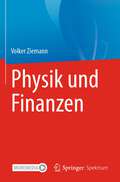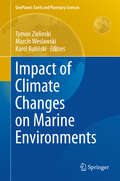- Table View
- List View
Psammic Peinobiomes: Nutrient-Limited Ecosystems of the Upper Orinoco and Rio Negro Basins (Ecological Studies #247)
by Joseph Alfred Zinck Otto Huber Pedro García Montero Ernesto MedinaThe book represents a multidisciplinary approach to understanding soil–landscape–vegetation relationships and, specifically, the ecophysiology of plant communities developing on sandy soils of very low fertility that are subject to seasonal flooding. It provides an overview of the white sand ecosystems within the Amazon basin, and focuses on the forest and herbaceous (meadows) vegetation growing on the dystrophic sandy soils of the upper Negro and Orinoco river basins. Several chapters describe physiographic aspects of the study area using integrated remote sensing and in situ sampling. By doing so they attain a comprehensive description of the origin and evolution of soils and landscapes, an advanced classification of soils, and a mapping of the geographic distribution of psammophilous vegetation. This volume also provides a phytosociological classification of extensive forested areas, and a detailed description of the structure and diversity of little-known herbaceous formations.It targets professionals in the fields of ecology, ecophysiology, geomorphology, soils, vegetation, and the environmental sciences. The information it offers may be of significant use to researchers, protected area planners, and environmental policy makers.
Aluminum Upcycled: Sustainable Design in Historical Perspective (Johns Hopkins Studies in the History of Technology)
by Carl A. ZimringBesides being the right thing to do for Mother Earth, recycling can also make money;¢;‚¬;€?particularly when it comes to upcycling, a zero waste practice where discarded materials are fashioned into goods of greater economic or cultural value. In Upcycling Aluminum, Carl A. Zimring explores how the metal;€™s abundance after World War II;¢;‚¬;€?coupled with the significant economic and environmental costs of smelting it from bauxite ore;¢;‚¬;€?led to the industrial production of valuable durable goods from salvaged aluminum. Beginning in 1886 with the discovery of how to mass produce aluminum, the book examines the essential part the metal played in early aviation and the world wars, as well as the troubling expansion of aluminum as a material of mass disposal. Recognizing that scrap aluminum was as good as virgin material and much more affordable than newly engineered metal, designers in the postwar era used aluminum to manufacture highly prized artifacts. Zimring takes us on a tour of post-1940s design, examining the use of aluminum in cars, trucks, airplanes, furniture, and musical instruments from 1945 to 2015. By viewing upcycling through the lens of one material, Zimring deepens our understanding of the history of recycling in industrial society. He also provides a historical perspective on contemporary sustainable design practices. Along the way, he challenges common assumptions about upcycling;€™s merits and adds a new dimension to recycling as a form of environmental absolution for the waste-related sins of the modern world. Raising fascinating questions of consumption, environment, and desire, Upcycling Aluminum is for anyone interested in industrial and environmental history, discard studies, engineering, product design, music history, or antiques.
Aluminum Upcycled: Sustainable Design in Historical Perspective (Johns Hopkins Studies in the History of Technology)
by Carl A. ZimringBesides being the right thing to do for Mother Earth, recycling can also make money;¢;‚¬;€?particularly when it comes to upcycling, a zero waste practice where discarded materials are fashioned into goods of greater economic or cultural value. In Upcycling Aluminum, Carl A. Zimring explores how the metal;€™s abundance after World War II;¢;‚¬;€?coupled with the significant economic and environmental costs of smelting it from bauxite ore;¢;‚¬;€?led to the industrial production of valuable durable goods from salvaged aluminum. Beginning in 1886 with the discovery of how to mass produce aluminum, the book examines the essential part the metal played in early aviation and the world wars, as well as the troubling expansion of aluminum as a material of mass disposal. Recognizing that scrap aluminum was as good as virgin material and much more affordable than newly engineered metal, designers in the postwar era used aluminum to manufacture highly prized artifacts. Zimring takes us on a tour of post-1940s design, examining the use of aluminum in cars, trucks, airplanes, furniture, and musical instruments from 1945 to 2015. By viewing upcycling through the lens of one material, Zimring deepens our understanding of the history of recycling in industrial society. He also provides a historical perspective on contemporary sustainable design practices. Along the way, he challenges common assumptions about upcycling;€™s merits and adds a new dimension to recycling as a form of environmental absolution for the waste-related sins of the modern world. Raising fascinating questions of consumption, environment, and desire, Upcycling Aluminum is for anyone interested in industrial and environmental history, discard studies, engineering, product design, music history, or antiques.
Statistik in der Geographie: Eine Exkursion durch die deskriptive Statistik
by Susanne Zimmermann-JanschitzMit der Statistik verhält es sich so wie mit der Stadt New York – entweder man liebt sie, oder man hasst sie. Was hat diese Feststellung jedoch mit vorliegendem Buch zu tun? Im Laufe der letzten Jahrzehnte hat sich die Geographie von ihrer länderkundlichen Betrachtungsweise umorientiert und ist um zahlreiche Schwerpunkte und Zugänge erweitert worden, etwa der Implementierung (geo-)technologischer Methoden, GIS und Fernerkundung, der Modellierung von Naturphänomenen oder sozialgeographischer Fragestellungen. Für etliche Aspekte benötigt man Kenntnisse in Statistik. Wie kann es gelingen, Studierende für diesen Themenbereich zu begeistern, der oftmals seit der Schule mit Respekt oder sogar Abneigung begegnet wird?Im Gegensatz zu technologischen bzw. mathematischen Inhalten eint sämtliche Geographinnen und Geographen die Begeisterung für eine Facette: die fürs Reisen. Warum also nicht Herausforderung und Begeisterung miteinander verbinden? Dieses Buch führt Sie auf eine Entdeckungsreise, eine Exkursion. Das Ziel der Reise istdas Verständnis der deskriptiven Statistik. Eingepackt in ausführliche Reisevor- und Nachbereitungen, die sowohl die Datengewinnung wie auch deren Visualisierung umfassen, führt Sie die Exkursion in einzelnen Etappen durch wichtige Kernelemente der beschreibenden Statistik. Dabei wird Unbekanntes mit Bekanntem verbunden, Unentdecktes schmackhaft aufbereitet und ein etwas „anderer“ Blickwinkel geschärft. Neugierig geworden? Dann nehmen Sie an dieser Entdeckungsreise teil und erkunden Sie die Grundlagen der Statistik. Eine gute Reise!
Metropolitan Regions, Planning and Governance
by Karsten Zimmermann Daniel Galland John HarrisonThe aim of this book is to investigate contemporary processes of metropolitan change and approaches to planning and governing metropolitan regions. To do so, it focuses on four central tenets of metropolitan change in terms of planning and governance: institutional approaches, policy mobilities, spatial imaginaries, and planning styles. The book’s main contribution lies in providing readers with a new conceptual and analytical framework for researching contemporary dynamics in metropolitan regions. It will chiefly benefit researchers and students in planning, urban studies, policy and governance studies, especially those interested in metropolitan regions.The relentless pace of urban change in globalization poses fundamental questions about how to best plan and govern 21st-century metropolitan regions. The problem for metropolitan regions—especially for those with policy and decision-making responsibilities—is a growing recognition that these spaces are typically reliant on inadequate urban-economic infrastructure and fragmented planning and governance arrangements. Moreover, as the demand for more ‘appropriate’—i.e., more flexible, networked and smart—forms of planning and governance increases, new expressions of territorial cooperation and conflict are emerging around issues and agendas of (de-)growth, infrastructure expansion, and the collective provision of services.
Governance and City Regions: Policy and Planning in Europe (Regions and Cities)
by Karsten Zimmermann Patricia FeiertagCity-regions are areas where the daily journeys for work, shopping and leisure frequently cross administrative boundaries. They are seen as engines of the national economy, but are also facing congestion and disparities. Thus, all over the world, governments attempt to increase problem-solving capacities in city-regions by institutional reform and a shift of functions. This book analyses the recent reforms and changes in the governance of city-regions in France, Germany and Italy. It covers themes such as the impact of austerity measures, territorial development, planning and state modernisation. The authors provide a systematic cross-country perspective on two levels, between six city-regions and between the national policy frameworks in these three countries. They use a solid comparative framework, which refers to the four dimensions functions, institutions and governance, ideas and space. They describe the course of the reforms, the motivations and the results, and consequently, they question the widespread metropolitan fever or resurgence of city-regions and provide a better understanding of recent changes in city-regional governance in Europe. The primary readership will be researchers and master students in planning, urban studies, urban geography, political science and governance studies, especially those interested in metropolitan regions and / or decentralisation. Due to the uniqueness of the work, the book will be of particular interest to scholars working on the comparative European dimension of territorial governance and planning.
Governance and City Regions: Policy and Planning in Europe (Regions and Cities)
by Karsten Zimmermann Patricia FeiertagCity-regions are areas where the daily journeys for work, shopping and leisure frequently cross administrative boundaries. They are seen as engines of the national economy, but are also facing congestion and disparities. Thus, all over the world, governments attempt to increase problem-solving capacities in city-regions by institutional reform and a shift of functions. This book analyses the recent reforms and changes in the governance of city-regions in France, Germany and Italy. It covers themes such as the impact of austerity measures, territorial development, planning and state modernisation. The authors provide a systematic cross-country perspective on two levels, between six city-regions and between the national policy frameworks in these three countries. They use a solid comparative framework, which refers to the four dimensions functions, institutions and governance, ideas and space. They describe the course of the reforms, the motivations and the results, and consequently, they question the widespread metropolitan fever or resurgence of city-regions and provide a better understanding of recent changes in city-regional governance in Europe. The primary readership will be researchers and master students in planning, urban studies, urban geography, political science and governance studies, especially those interested in metropolitan regions and / or decentralisation. Due to the uniqueness of the work, the book will be of particular interest to scholars working on the comparative European dimension of territorial governance and planning.
Nachhaltigkeit wofür?: Von Chancen und Herausforderungen für eine nachhaltige Zukunft
by Friedrich M. ZimmermannGlobale Herausforderungen und die Notwendigkeit umzudenken – wie soll das funktionieren? Dies ist die Kernfrage, die die Autorinnen und Autoren dieses Buch aus unterschiedlichen Perspektiven beleuchten und durchaus kritisch und kontroversiell diskutieren. Sie debattieren Gegenwarts- und Zukunftsfragen anhand der großen Herausforderungen unserer globalisierten Welt. Dazu gehören beispielweise der Klimawandel, die Ausbeutung der natürlichen Ressourcen, das Diktat des Konsums, der Nord-Süd-Konflikt und die Explosion der Megastädte des Südens sowie die sich weit öffnende Kluft zwischen Arm und Reich, aber auch neue Dimensionen von Integration und Inklusion. Nachhaltigkeit wofür? beleuchtet diese und viele andere Aspekte holistisch und integrativ sowie unter Berücksichtigung der ökonomischen, der sozialen und der ökologischen Säule der Nachhaltigkeit und erläutert sie in ihrer Komplexität und gegenseitigen Vernetzung. Neben theoretisch argumentierten Lösungsstrategien zeigt das Buch zukunftsfähige Optionen für nachhaltige Entwicklungen auf und gibt Beispiele aus der Praxis. Die Intention ist eindeutig: Für eine zukunftsfähige Entwicklung unseres Planeten müssen wir dringend umdenken – und vor allem „umhandeln“. Damit ist das Buch mehr als ein Lehrbuch: Es soll einen wissenschaftlich fundierten Beitrag zur Bewusstseinsbildung für nachhaltige Entwicklung nicht nur für Studierende, sondern insbesondere für alle diejenigen leisten, die an einer zukunftsfähigen Entwicklung von Gesellschaft, Wirtschaft und Umwelt Interesse haben und ihren Beitrag zu einem nachhaltigen globalen Wandel leisten möchten. Brechen wir gemeinsam auf in eine nachhaltigere Welt!
Fluid Flow in Fractured Rocks
by Robert W. Zimmerman Adriana PalusznyFLUID FLOW IN FRACTURED ROCKS "The definitive treatise on the subject for many years to come" (Prof. Ruben Juanes, MIT) Authoritative textbook that provides a comprehensive and up-to-date introduction to fluid flow in fractured rocks Fluid Flow in Fractured Rocks provides an authoritative introduction to the topic of fluid flow through single rock fractures and fractured rock masses. This book is intended for readers with interests in hydrogeology, hydrology, water resources, structural geology, reservoir engineering, underground waste disposal, or other fields that involve the flow of fluids through fractured rock masses. Classical and established models and data are presented and carefully explained, and recent computational methodologies and results are also covered. Each chapter includes numerous graphs, schematic diagrams and field photographs, an extensive reference list, and a set of problems, thus providing a comprehensive learning experience that is both mathematically rigorous and accessible. Written by two internationally recognized leaders in the field, Fluid Flow in Fractured Rocks includes information on: Nucleation and growth of fractures in rock, with a multiscale characterization of their geometric traits Effect of normal and shear stresses on the transmissivity of a rock fracture and mathematics of fluid flow through a single rock fracture Solute transport in rocks, with quantitative descriptions of advection, molecular diffusion, and dispersion Fluid Flow in Fractured Rocks is an essential resource for researchers and postgraduate students who are interested in the field of fluid flow through fractured rocks. The text is also highly suitable for professionals working in civil, environmental, and petroleum engineering.
Fluid Flow in Fractured Rocks
by Robert W. Zimmerman Adriana PalusznyFLUID FLOW IN FRACTURED ROCKS "The definitive treatise on the subject for many years to come" (Prof. Ruben Juanes, MIT) Authoritative textbook that provides a comprehensive and up-to-date introduction to fluid flow in fractured rocks Fluid Flow in Fractured Rocks provides an authoritative introduction to the topic of fluid flow through single rock fractures and fractured rock masses. This book is intended for readers with interests in hydrogeology, hydrology, water resources, structural geology, reservoir engineering, underground waste disposal, or other fields that involve the flow of fluids through fractured rock masses. Classical and established models and data are presented and carefully explained, and recent computational methodologies and results are also covered. Each chapter includes numerous graphs, schematic diagrams and field photographs, an extensive reference list, and a set of problems, thus providing a comprehensive learning experience that is both mathematically rigorous and accessible. Written by two internationally recognized leaders in the field, Fluid Flow in Fractured Rocks includes information on: Nucleation and growth of fractures in rock, with a multiscale characterization of their geometric traits Effect of normal and shear stresses on the transmissivity of a rock fracture and mathematics of fluid flow through a single rock fracture Solute transport in rocks, with quantitative descriptions of advection, molecular diffusion, and dispersion Fluid Flow in Fractured Rocks is an essential resource for researchers and postgraduate students who are interested in the field of fluid flow through fractured rocks. The text is also highly suitable for professionals working in civil, environmental, and petroleum engineering.
Wider die „Zwei Kulturen“: Fachübergreifende Inhalte in der Hochschulausbildung (Ladenburger Diskurs)
by Walther C. Zimmerli0 d Den in diesem Band gesammelten Beiträgen geht es um konkrete Hinweise zur Überwindung der Kluft zwischen der naturwissenschaftlich-technischen und der geistig-sozialen Welt. Dabei wird an der universitären Ausbildung von Ingenieuren, Geistes- und Sozialwissenschaftlern angesetzt. Die Theoretische Grundannahme, daß ein neues "technologisches" Zeitalter heraufziehe, wird anhand einer fundamentalen Änderung in den Ausbildungsstrukturen von Hochschulen im deutschsprachigen Raum sichtbar gemacht. Dieses Buch zeichnet sich dadurch aus, daß es nicht kurzatmige Hochschulreformpläne vorstellt, sondern auf Erfahrungen beruhende Orientierung bietet.
Climate Change and Genocide: Environmental Violence in the 21st Century
by Jürgen ZimmererClimate change caused by human activity is the most fundamental challenge facing mankind in the 21st century, since it will drastically alter the living conditions of millions of people, mainly in the Global South. Environmental violence, including resource crises such as peak fossil fuel, will lie at the heart of future conflicts. However, Genocide Studies have so far neglected this subject, due to the emphasis that traditional genocide scholarship places on ideology and legal prosecution, leading to a narrow understanding of the driving forces of genocide. This books aims at changing this, initiating a dialogue between scholars working in the areas of climate change and genocide. Research into genocide as well as climate change is a highly interdisciplinary endeavour, transcending the boundaries of established disciplines. Contributions to this book address this by approaching the subject from a wide array of methodological, theoretical, disciplinary and regional perspectives. As all the contributions show, climate change is a major threat multiplier for violence or non-violent destruction and any understanding of prevention needs to take this into account. They offer a basis for much needed Critical Prevention Studies, which aims at sustainable prevention.This book was originally published as a special issue of the International Journal of Human Rights.
Climate Change and Genocide: Environmental Violence in the 21st Century
by Jürgen ZimmererClimate change caused by human activity is the most fundamental challenge facing mankind in the 21st century, since it will drastically alter the living conditions of millions of people, mainly in the Global South. Environmental violence, including resource crises such as peak fossil fuel, will lie at the heart of future conflicts. However, Genocide Studies have so far neglected this subject, due to the emphasis that traditional genocide scholarship places on ideology and legal prosecution, leading to a narrow understanding of the driving forces of genocide. This books aims at changing this, initiating a dialogue between scholars working in the areas of climate change and genocide. Research into genocide as well as climate change is a highly interdisciplinary endeavour, transcending the boundaries of established disciplines. Contributions to this book address this by approaching the subject from a wide array of methodological, theoretical, disciplinary and regional perspectives. As all the contributions show, climate change is a major threat multiplier for violence or non-violent destruction and any understanding of prevention needs to take this into account. They offer a basis for much needed Critical Prevention Studies, which aims at sustainable prevention.This book was originally published as a special issue of the International Journal of Human Rights.
Agricultural Ethics - An Invitation: An Invitation
by Robert L. ZimdahlI write because I am concerned that I and my agricultural colleagues have avoided addressing the moral dimension of the environmental and social problems we have contributed to. I hope for an exchange of ideas about agriculture's moral dilemmas. I encourage my readers to engage in a collective conversation about the dilemmas and avoid remaining in what Merton calls "the collective arrogance and despair of his own herd." If those engaged in agriculture continue to ignore and fail to realize our common difficulties they will be addressed and resolved by societal pressure and political action, which may not yield the resolution we favor. The book's goal is not to resolve the moral dilemmas raised. It is to raise them and encourage thought and discussion. It will ask but not answer why nearly all involved in agriculture have not addressed the moral concerns voiced by the general public. The agricultural enterprise is committed to the benefits and future success of the present, very productive, chemical, capital, and energy intensive system, which is, in the minds of many, not sustainable. The internal justification invokes the moral claim that they feed the world's population. The question remains whether or not the prevailing moral justification of feeding the world is adequate given all the issues modern, developed country agriculture faces: pesticides in soil, water, and food, cruelty to animals, Biotech/GMO's, corporate agriculture, pollution by animal factory waste, exploitation of and cruelty to migrant labor.
Local Geometry of the Fermi Surface: And High-Frequency Phenomena in Metals
by Natalya A. ZimbovskayaA treatment of the Fermi-liquid theory of high-frequency phenomena in metals, in paricular the effects due to local features in the geometry of the Fermi surface. The text develops a consistent theory of several effects, such as cyclotron resonances in magnetic fields normal to the surface. Topics covered include: basic equations of the Fermi-liquid theory; cyclotron Doppler on waves; local anomalies in the Fermi surface; cyclotron resonancce in metals; magneto-acoustic oscillations and the local geometry of the Fermi surface.
Issues in Bioinvasion Science: EEI 2003: a Contribution to the Knowledge on Invasive Alien Species
by Bernardo Zilletti Laura Capdevila-ArguellesThis volume presents key contributions of the First National Conference on Invasive Alien Species, held in Spain in 2003. Topics included cut across all aspects of non-native species invasions. Experts from universities, public administration, NGOs and environmental enterprises and authorities on biological invasions from other countries participated in the conference, which aimed to go beyond national boundaries to tackle the complex biological issues of invasive alien species.
Emission of Radio Waves in Particle Showers: Validation of Microscopic Simulations with the SLAC T-510 Experiment and their Potential in the Future Square Kilometre Array (Springer Theses)
by Anne ZillesThis thesis offers the first laboratory validation of microscopic simulations of radio emission from particle showers, including a detailed description of the simulation study. It presents a potential future avenue for resolving the mass composition of cosmic rays via radio detection of air showers. Particle showers are created from cascading interactions when high-energy particles collide with matter, e.g. with air in the case of cosmic radiation, or with a particle detector in the case of experiments at CERN. These showers can consist of billions of particles, mostly electrons, positrons and photons. They emit radio waves when the absorbing medium is in a magnetic field, and this radio emission can be used as a novel means of detecting and drawing inferences on the shower and the primary particle. The new method is currently being established in cosmic ray research, where large antenna arrays may soon replace or complement traditional particle detectors. In this study, a complete microscopic simulation of a radio-emission experiment conducted at Stanford Linear Accelerator Center (SLAC), Stanford/USA, is performed, and the underlying physical models are validated. The model is subsequently applied to the Square Kilometre Array (SKA) project, which is a large interferometer for radio astronomy. It is demonstrated that the SKA, with some modifications, might also be used for cosmic ray research based on radio detection of high-energy particles from the cosmos.
Geotechnik
by Konrad Zilch Claus Jürgen Diederichs Rolf Katzenbach Klaus J. BeckmannStudierende des Bauingenieurwesens werden durch kompaktes Wissen auf ihre komplexen Aufgaben vorbereitet und auf Vertiefungsmöglichkeiten hingewiesen. Praktiker können ihren Wissensstand insbesondere auch auf solchen Gebieten aktualisieren, die nicht zu ihrem Alltagsgeschäft gehören.
The Double Constraint Inversion Methodology: Equations and Applications in Forward and Inverse Modeling of Groundwater Flow (SpringerBriefs in Applied Sciences and Technology)
by Wouter Zijl Florimond De Smedt Mustafa El-Rawy Okke BatelaanThis book describes a novel physics-based approach to inverse modeling that makes use of the properties of the equations governing the physics of the processes under consideration. It focuses on the inverse problems occurring in hydrogeology, but the approach is also applicable to similar inverse problems in various other fields, such as petroleum-reservoir engineering, geophysical and medical imaging, weather forecasting, and flood prediction. This approach takes into consideration the physics – for instance, the boundary conditions required to obtain a well-posed mathematical problem – to help avoid errors in model building and therefore enhance the reliability of the results. In addition, this method requires less computation time and less computer memory. The theory is presented in a comprehensive, not overly mathematical, way, with three practice-oriented hydrogeological case studies and a comparison with the conventional approach illustrating the power of the method. Forward and Inverse Modeling of Groundwater Flow is of use to researchers and graduate students in the fields of hydrology, as well as to professional hydrologists within industry. It also appeals to geophysicists and those working in or studying petroleum reservoir modeling and basin modeling.
Situative Karten: Orientierung, Exploration und Navigation mit spezialisierbaren Karten
by Hendrik ZiezoldComputerimplementierte interaktive Karten werden in den unterschiedlichsten Situationen genutzt, wie etwa zur Orientierung und Navigation oder zur Exploration und Datenverwaltung. Auf der Basis interdisziplinärer Studien historischer und moderner Kartenkonzepte und deren Gebrauch erforscht Hendrik S. Ziezold Karten nicht nur als Resultate kartographischer Projektionsverfahren, sondern als bewusst konzipierte Visualisierungen von Informationen. Er erarbeitet ein Modell für situative Karten, das sich sowohl für die Entwicklung neuer als auch zur Evaluierung bestehender Entwürfe eignet. Mit Hilfe neu erstellter und exemplarisch realisierter Visualisierungs- und Interaktionskonzepte demonstriert der Autor die Anwendbarkeit des Modells.
Adoption of Emerging Information and Communication Technology for Sustainability
by Ewa Ziemba JarosławThis book represents an important voice in the discourse on the adoption of emerging ICT for sustainability. It focuses on how emerging ICT acts as a crucial enabler of sustainability, offering new forward-looking approaches to this field. The book explores how emerging ICT adoption drives sustainability efforts in business and public organizations, promoting ecological, economic, social, cultural, and political sustainability. The book's theoretical discussions, conceptual approaches, empirical studies, diverse perspectives, and views make it a valuable and comprehensive reference work. Appealing to both researchers and practitioners, this book provides significant areas for research and practice related to the contribution of emerging ICT adoption to sustainability. It also suggests vital considerations for programming and building sustainable development-driven emerging ICT adoption. Readers will find answers to important contemporary questions, such as: What are the concepts, frameworks, models, and approaches to enhance sustainable development through the adoption of emerging ICT? How does the adoption of emerging ICT influence sustainability? How can emerging ICT be adopted to enhance sustainability? What are the current practices and successful cases of emerging ICT adoption for sustainability? What factors influence emerging ICT adoption to enhance sustainability?
Physics and Finance (Undergraduate Lecture Notes in Physics)
by Volker ZiemannThis book introduces physics students to concepts and methods of finance. Despite being perceived as quite distant from physics, finance shares a number of common methods and ideas, usually related to noise and uncertainties. Juxtaposing the key methods to applications in both physics and finance articulates both differences and common features, this gives students a deeper understanding of the underlying ideas. Moreover, they acquire a number of useful mathematical and computational tools, such as stochastic differential equations, path integrals, Monte-Carlo methods, and basic cryptology. Each chapter ends with a set of carefully designed exercises enabling readers to test their comprehension.
Physik und Finanzen
by Volker ZiemannDieses Buch führt Physikstudenten in die Konzepte und Methoden der Finanzwissenschaft ein. Obwohl die Finanzwissenschaft als recht weit von der Physik entfernt wahrgenommen wird, teilt sie eine Reihe gemeinsamer Methoden und Ideen, die in der Regel mit Rauschen und Unsicherheiten zu tun haben. Durch die Gegenüberstellung der wichtigsten Methoden mit Anwendungen in der Physik und im Finanzwesen werden sowohl die Unterschiede als auch die Gemeinsamkeiten deutlich, was den Studierenden ein tieferes Verständnis der zugrunde liegenden Ideen vermittelt. Darüber hinaus lernen sie eine Reihe nützlicher mathematischer und rechnerischer Werkzeuge kennen, wie stochastische Differentialgleichungen, Pfadintegrale, Monte-Carlo-Methoden und grundlegende Kryptologie. Jedes Kapitel endet mit einer Reihe sorgfältig ausgearbeiteter Übungen, mit denen die Leser ihr Verständnis überprüfen können.
Impact of Climate Changes on Marine Environments (GeoPlanet: Earth and Planetary Sciences)
by Tymon Zielinski Marcin Weslawski Karol KulińskiThis book contributes to the current discussion on global environmental changes by discussing modifications in marine ecosystems related to global climate changes. In marine ecosystems, rising atmospheric CO2 and climate changes are associated with shifts in temperature, circulation, stratification, nutrient input, oxygen concentration and ocean acidification, which have significant biological effects on a regional and global scale.Knowing how these changes affect the distribution and abundance of plankton in the ocean currents is crucial to our understanding of how climate change impacts the marine environment.Ocean temperatures, weather and climatic changes greatly influence the amount and location of nutrients in the water column. If temperatures and currents change, the plankton production cycle may not coincide with the reproduction cycle of fish.The above changes are closely related to the changes in radiative forcing, which initiate feedback mechanisms like changes in surface temperature, circulation, and atmospheric chemistry.
